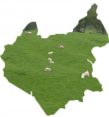Market Bosworth is a complex parish, which includes the eponymous town and its five chapelries of Barlestone, Carlton, Sutton Cheney, Shenton, and Osbaston. It is in west Leicestershire, about 13 miles from Leicester.
No response has survived to the 1669 return of conventicles.[1] The three nonconformists noted in 1676 appear to come from the town itself.[2]
The visitation questionnaires of the early 18th century do not distinguish between those dissenters living in the town of Market Bosworth and those living in its chapelries. In total there were 15 families of dissenters in the parish in 1706: 7 were Baptists and 8 were Presbyterians or Independents, and there were meeting houses for Baptists in Barlestone and for Presbyterians at Carlton. In 1712 we are presented for the first time with separate figures for the town and each chapelry. Market Bosworth town contained 140 families, including three families of Presbyterians or Independents and one of Baptists. No meeting house was mentioned within the town.[3]
The information which follows relates specifically to the town of Market Bosworth, and a separate web page covers nonconformity in Barlestone, Carlton, Sutton Cheney, Shenton, and Osbaston from the 18th century
A meeting place was established at the home of a dissenter in 1778, although there is no record of the denomination.[4]
Other sources recorded the presence of Baptists, Independents and Primitive Methodists in the town.
General Baptists
William Peasant was licensed as a Baptist teacher in 1672, and was presented for not attending the parish church.[5] No further records have been noted until 1829, when the Return for Religious Meeting Places recorded 100 General Baptists meeting in the town.[6] White’s Directory of 1846 recorded the presence of a chapel, but provided no details. A new chapel was erected in 1848 with 150 sittings, at a cost of £200.[7] However, attendance figures provided by the 1851 Religious Census are unclear. It recorded 160 sittings, but with an attendance of 80, 250 and 300 for the three services held on census day. Average attendance was marked at ‘about 80’ for one service, held in the morning. Sunday School attendance was marked at 45 for a morning session, both for census day and for average attendance. It is worth noting that a letter attached to the census form was lost, and that the form itself shows an appearance of being erased and re-entered several times.[8]
Sources after this date confirm the continued presence of Baptists into the 20th century, but Kelly’s Directory of 1895 noted that the chapel contained only 100 sittings.[9] The chapel is no longer there in 2015.
Independents/Congregationalists
The earliest evidence of Independents is of a chapel they erected in 1799. This was enlarged in 1811, after which it contained 200 sittings.[10] The 1829 Religious Return counted their population at 200.[11] The 1851 Religious Census provides slightly different information concerning the build year and seating capacity of the chapel, stating the former as 1795, with extensions from 1811-12, and the latter as 184 (100 of them free), with some room in the aisle.
On census day, a congregation of 117 was recorded for one service, held in the evening. The census form noted that an afternoon service was cancelled on census day so the chapel could be used by Primitive Methodists, and that this service would normally be attended by 60-100 worshippers. This may have affected attendance for the evening service, but the average figure for this was not given. As for Sunday School, eight children were present for an evening session. The notes also recorded that about 40 children would usually be present for an afternoon session.[12]
Sources after 1851 use the term Congregationalist, and confirm their continued presence into the 20th century. The chapel is no longer there in 2015.
Primitive Methodists
Primitive Methodists erected a chapel in 1850 at a cost of £110.[13] In 1851, it contained 134 sittings (80 of them free) with attendance on census day recorded at 70 and 120 for services in the afternoon and evening respectively. No average figures were given, and there is no evidence of a Sunday School.[14]
Sources after 1851 confirm the continued presence of Primitive Methodists into the late 19th century, but with no mention of them at all after 1881. The chapel is no longer there in 2015.
Notes
[1] R.H. Evans, ‘Nonconformists in Leicestershire in 1669’, Trans LAHS, 25 (1949).
[2] A. Whiteman, The Compton Census of 1676: A Critical Edition (London, 1986), p. 331
[3] J. Broad (ed.), Bishop Wake’s summary of visitation returns from the diocese of Lincoln, 1706-1715. Part 2, Outside Lincolnshire (Huntingdonshire, Hertfordshire, Bedfordshire, Leicestershire, Buckinghamshire) (Oxford, 2012), pp. 871-2
[4] Leicestershire and Rutland County Record Office (ROLLR), list of religious meeting places, Market Bosworth, Leicestershire, QS 44/1/2.
[5] A Betteridge, ‘Early Baptists in Leicestershire and Rutland III: General Baptists’, Baptist Quarterly, 25 (1973), p. 367
[6] 1829 Return of Religious Meeting Places, entry for Market Bosworth, QS 95/2/1/171.
[7] White, Hist. Gaz. & Dir. Leics. (Sheffield, 1863) p. 685.
[8] 1851 Religious Census of England and Wales, entry for General Baptists, Market Bosworth, HO 129/413/17.
[9] Kelly’s Dir. (1895) p. 282.
[10] White, Hist. Gaz. & Dir. Leics. (Sheffield, 1863) p. 685
[11] 1829 Return, QS 95/2/1/171..
[12] 1851 Religious Census, entry for Independents, HO 129/413/16.
[13] White, Hist. Gaz. & Dir. Leics. (Sheffield, 1863) p. 685.
[14] 1851 Religious Census, entry for Primitive Methodists, HO 129/413/18.
